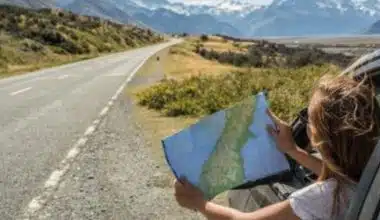Are you embarking on a trip and don’t know how to plan? Planning a road trip involves choosing your destination, determining the duration, creating an itinerary, researching attractions and accommodations, estimating travel time and distances, packing essentials, planning meals, and determining your budget. It’s essential to consider the facts before embarking on a journey. Using online mapping tools and planning can ensure a smooth and memorable journey.
How To Plan A Road Trip
Planning a road trip can be an exciting and enjoyable experience. Whether you’re embarking on a solo adventure or traveling with friends and family, careful planning can help ensure a smooth and memorable journey.
Steps on How To Plan A Road Trip
Here are some steps to help you plan a road trip:
#1. Choose your Destination
Decide where you want to go and what places you want to visit along the way. Consider factors such as distance, attractions, and the time you have available.
#2. Determine the Duration
Decide how long you want your road trip to be. Consider the number of days you have available and how much time you want to spend at each destination.
#3. Create an Itinerary
Plan your route and create a detailed itinerary. Identify the cities or towns where you will stop, the attractions you want to visit, and the activities you want to do. Be sure to include some flexibility in your schedule to allow for unexpected detours or spontaneous adventures.
#4. Research Attractions and Accommodations
Look for interesting attractions, landmarks, and activities along your route. Research accommodations such as hotels, motels, campgrounds, or vacation rentals in each destination. Consider booking accommodations in advance, especially during peak travel seasons.
#5. Estimate Travel Time and Distances
Use online mapping tools or navigation apps to estimate travel times and distances between destinations. This will help you plan your daily driving schedule and ensure you have enough time to explore each location.
#6. Pack Essentials
Make a packing list of essential items you’ll need for your road trip. This may include clothing, toiletries, medications, snacks, entertainment, and any necessary travel documents. Don’t forget to pack a roadside emergency kit and ensure your vehicle is in good condition.
#7. Plan for Meals
Decide whether you’ll eat at restaurants along the way or if you prefer to pack your meals. Research dining options in each destination and consider trying local cuisine for a unique experience.
#8. Budget and Expenses
Determine your budget for the road trip, including fuel costs, accommodations, meals, attractions, and any other expenses. Consider setting aside some extra money for unexpected expenses or souvenirs.
#9. Entertainment and Music
Create a road trip playlist with your favorite songs or podcasts to keep you entertained during the journey. Consider downloading offline maps or using navigation apps to help you navigate and discover interesting places along the way.
#10. Check your Vehicle
Before hitting the road, ensure that your vehicle is in good working condition. Check the tires, brakes, oil, coolant, and other essential components. If needed, get a maintenance check or tune-up done by a professional mechanic.
How To Plan A Road Trip Across The Country
A cross-country road trip offers a unique opportunity to explore the diverse landscapes and cultures of the United States. Planning a road trip across the country requires some additional considerations.
Steps on How To Plan A Road Trip Across The Country
These steps will help to plan a cross-country road trip
#1. Choose your Route
Decide on the route you want to take across the country. Consider factors such as scenic drives, attractions, and the time you have available. You can choose from popular routes like Route 66, the Pacific Coast Highway, or create your custom route.
#2. Consider Travel Apps and Resources
Take advantage of travel apps and resources that can enhance your road trip experience. Use navigation apps like Google Maps or Waze for real-time traffic updates and route recommendations. Apps like Roadtrippers can help you discover interesting attractions and plan your itinerary.
#3. Plan your Itinerary
Create a detailed itinerary for your cross-country road trip. Determine the number of days you’ll spend in each location and the driving distances between them. Be sure to include some flexibility in your schedule to allow for unexpected detours or additional time at certain destinations.
#4. Book Accommodations
Research and book accommodations in advance, especially if you’re traveling during peak seasons. Consider a mix of hotels, motels, campgrounds, or vacation rentals depending on your preferences.
#5. Check for Permits or Passes
If you plan to visit national parks or other protected areas, check if any permits or passes are required. Some parks may have limited access or require reservations, so plan accordingly.
#6. Plan for Time Zones
Take into account the time zone changes you’ll encounter during your journey. Adjust your itinerary accordingly to account for any time differences and plan for breaks or overnight stays to avoid fatigue.
#7. Budget and Expenses
Determine your budget for the cross-country road trip, including fuel costs, accommodations, meals, attractions, and any other expenses. Consider setting aside some extra money for unexpected expenses or spontaneous activities.
#8. Check for Travel Advisories
Stay updated on any travel advisories or road conditions along your route. Check for any closures, construction, or weather-related issues that may affect your journey. Websites like the Department of Transportation or travel forums can provide valuable information.
#9. Research Transportation Options
Decide on the mode of transportation for your cross-country road trip. If you have your vehicle, ensure it is reliable and well-suited for long-distance travel. Alternatively, consider renting a car or using a camper van for a more adventurous experience.
#10. Plan for Rest
While it’s important to make the most of your cross-country journey, don’t forget to plan for relaxation. Include downtime in your itinerary to unwind, recharge, and enjoy the scenery.
Steps on How To Plan A Road Trip With Hotel Stops
Planning a road trip with hotel stops requires careful consideration to ensure a comfortable and enjoyable journey.
#1. Choose your Route
Determine the route you want to take for your road trip. Consider scenic drives, attractions, and the time you have available. Use online mapping tools or navigation apps to plan your route and identify potential stops along the way.
#2. Research Hotel Options
Look for hotels along your route that fit your budget and preferences. Consider factors such as location, amenities, customer reviews, and availability. Websites like Booking.com, Expedia, or hotel chains’ official websites can help you find suitable accommodations.
#3. Determine the Number of Hotel Stops
Decide how many hotel stops you want to make during your road trip. This will depend on the duration of your trip, the distance you plan to cover each day, and your personal preferences. Consider balancing driving time with time for rest and exploration.
#4. Plan the Duration of Each Hotel Stay
Determine how many nights you want to stay at each hotel stop. This will depend on the attractions and activities available in the area, as well as your interests. Some stops may require more time to fully explore, while others may be shorter overnight stays.
#5. Book Accommodations in Advance
Once you have identified the hotels you want to stay at, make reservations in advance. This is especially important if you’re traveling during peak seasons or to popular destinations. Booking in advance ensures you have a guaranteed place to stay and can help you secure better rates.
#6. Consider Hotel Amenities
Take into account the amenities offered by the hotels you choose. This can include features like complimentary breakfast, parking facilities, Wi-Fi access, fitness centers, or swimming pools. Prioritize amenities that are important to you and align with your preferences.
#7. Plan for Relaxation
Allocate time for rest during your road trip. Consider staying at hotels with comfortable beds, quiet surroundings, and a peaceful ambiance. This will help you rejuvenate and prepare for the next leg of your journey.
#8. Be Flexible with your Itinerary
While it’s important to have a plan, be open to making adjustments along the way. Unexpected opportunities or changes in circumstances may arise, and being flexible allows you to make the most of your road trip experience.
#9. Pack Essentials for Hotel Stays
Pack essential items for your hotel stays, such as toiletries, comfortable clothing, chargers for electronic devices, and any necessary travel documents. Consider bringing a small travel-sized laundry detergent if you plan to do laundry during your trip.
#10. Budget for Hotel Expenses
Include hotel expenses in your overall budget for the road trip. Consider factors such as nightly rates, taxes, and any additional fees. It’s also a good idea to have some extra cash or a credit card for incidentals or unexpected expenses.
How To Plan A Road Trip Across The US
Planning a road trip across the United States involves several steps. Start by choosing a route, researching attractions and stops along the way, and creating a detailed itinerary. Book accommodations in advance and consider transportation options. Pack essentials, budget for expenses, and plan for meals. Stay updated on travel advisories and keep important documents organized. Finally, enjoy the journey and take breaks to rest and explore.
Benefits Of Planning A Road Trip Across The US
Planning a road trip across the US offers several benefits that contribute to a memorable and enjoyable experience.
#1. Flexibility and Freedom
A road trip allows you to have complete control over your itinerary, giving you the freedom to explore at your own pace. You can make spontaneous stops, and detours, and adjust your plans as you go along.
Traveling by road provides opportunities to discover lesser-known attractions and hidden gems that may not be easily accessible by other means of transportation. You can stumble upon charming small towns, scenic viewpoints, and local treasures that are off the beaten path.
#3. Immersive Experience
Road trips allow you to immerse yourself in the diverse landscapes, cultures, and communities across the country. You can interact with locals, try regional cuisine, and gain a deeper understanding of different regions and their unique characteristics.
#4. Inspiration and Creativity
Traveling through different landscapes, meeting new people, and experiencing diverse cultures can spark inspiration and fuel creativity. A road trip across the US can provide a fresh perspective, allowing you to tap into your creativity and find inspiration for various artistic pursuits.
#5. Cost-Effective
Road trips can be a cost-effective way to travel, especially if you’re traveling with a group. By driving, you can save on airfare and have the flexibility to pack your food, reducing dining expenses. Additionally, you can choose accommodations that fit your budget and make use of travel discounts or loyalty programs.
#6. Scenic Drives and Landscapes
The United States is known for its stunning landscapes and scenic drives. A road trip allows you to witness the beauty of national parks, coastal routes, mountain ranges, and iconic landmarks firsthand. You can enjoy breathtaking views and capture memorable photos along the way.
#7. Sense of Adventure
Embarking on a road trip across the US brings a sense of adventure and excitement. It allows you to step out of your comfort zone, try new things, and embrace the unknown. The journey itself becomes an adventure filled with anticipation and discovery.
#8. Flexibility in Route Selection
When planning a road trip, you have the flexibility to choose the route that best suits your interests and preferences. You can opt for a coastal drive, a scenic mountain route, or a combination of various regions to create a unique and personalized journey.
#9. Photography Opportunities
If you’re a photography enthusiast, a road trip across the US provides an abundance of picturesque scenes to capture. From iconic landmarks to stunning landscapes, you’ll have countless opportunities to document your journey and create stunning visual memories.
#10. Creating Lifelong Memories
Road trips are known for creating lifelong memories. The unique experiences, encounters, and adventures you have along the way will stay with you for years to come, and you’ll have stories to share and reminisce about with friends and family.
How Do You Plan A Trip Step By Step?
Planning a trip involves several steps. Start by deciding on the destination and setting a travel budget. Research the destination, choose travel dates, and book transportation and accommodation. Plan activities and sightseeing, pack essentials, and check travel advisories and insurance. Notify banks and credit card companies, create an itinerary, and prepare for the trip. Finally, embark on your journey with a positive mindset and enjoy the experience.
How Do I Prepare Myself For A Road Trip?
To prepare yourself for a road trip, schedule an appointment with an automotive service technician, clean and organize your car, prepare snacks and drinks, plan your route using a map or GPS, pack essential items like first-aid kits, emergency kits, and a flashlight, budget for expenses, and get enough rest to ensure a safe and enjoyable journey.
How Do I Plan A Road Trip To All The States?
Planning a road trip to all the states in the US requires careful consideration and preparation. Choose your route, research and map out attractions, determine the duration of the trip, plan accommodations, set a budget, prepare your vehicle, pack smart, stay organized, prioritize safety, and enjoy the journey. With thorough planning and organization, a road trip to all the states can be an exciting and memorable adventure.
How Do You Write A Road Trip?
Writing a road trip story involves choosing a theme or purpose, developing characters, setting the stage, plotting the journey, describing the sights and sounds, capturing the characters’ emotions, including memorable encounters, creating tension and conflict, showcasing themes and lessons, and crafting a memorable ending. By incorporating these elements, you can create an engaging and immersive road trip story.
How Do I Plan A Trip In Easy Steps?
Planning a trip in 10 steps involves deciding on your destination, setting dates, setting a budget, researching your destination, booking flights, building an itinerary, booking accommodation, planning transportation, packing and preparing, and enjoying the trip. These steps help minimize stress and maximize enjoyment, ensuring a memorable and enjoyable experience.
What Information Should Be Included In A Trip Plan?
A comprehensive trip plan should include basic information (traveler names and contact details), destination details, transportation information, accommodation details, planned activities and sightseeing, emergency contacts, health and safety considerations, travel document information, budget and expenses, and any additional notes or special considerations. Keeping an organized and detailed trip plan helps ensure a smooth and well-prepared travel experience.
Conclusion
Cross-country road trips provide a unique opportunity to explore the United States’ diverse landscapes and cultures. To plan a road trip with hotel stops, choose your route, research hotel options, determine the number of stops, plan the duration of each stay, and book accommodations in advance. Balancing driving time with rest and exploration is crucial. Planning a road trip across the United States offers numerous benefits, and photography opportunities. By choosing a route, researching attractions, and creating a detailed itinerary, travelers can explore lesser-known attractions, immerse themselves in diverse cultures, and tap into their creativity.
- HOW TO PLAN A ROAD TRIP: The Ultimate Guide
- The Ultimate Guide: How to Plan the Best Scenic Road Trip
- PLANNING A TRIP: The Ultimate Guide
- ROAD TRIP USA: Your Ultimate Guide to Discovering America’s Hidden Gems
- THINGS TO DO ON A ROAD TRIP: 21+ Ideas for a Memorable Adventure






